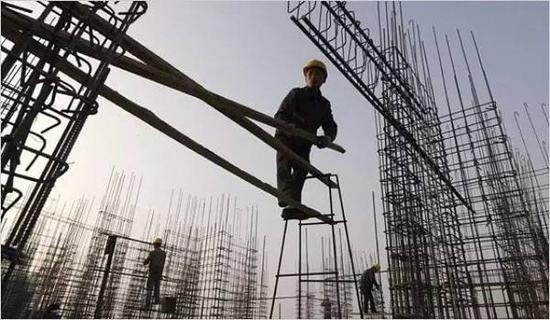Article/Zhu Haibin, columnist of Sina Financial Opinion Leader Column (WeChat official account kopleader)
Looking ahead to 2017, we expect that the economic growth rate will moderate to 6.5% from 6.7% in 2016. Considering structural factors, 2017 is not much different from 2016. For example, in terms of labor force, the working age population will continue to decline, the population will be aging, and the number of new migrant workers will also show a significant downward trend.
 Zhu Haibin: It is estimated that the GDP growth rate will moderate to 6.5% in 2017
Zhu Haibin: It is estimated that the GDP growth rate will moderate to 6.5% in 2017 In 2016, the GDP growth rate successfully achieved the previously set growth target of 6.5% - 7%. If the financial services industry is excluded, the real GDP growth hit the bottom in the second quarter of 2015 (only 6.2% year-on-year), and then gradually rose to 6.8% year-on-year growth in the third quarter of 2016. This round of economic recovery is mainly due to infrastructure, real estate investment and strong car sales. The government's macro policies to stabilize growth also played a significant role, including proactive fiscal policies, accelerated credit growth and the devaluation of the RMB exchange rate.
In 2016, a remarkable feature of China's economic cyclical recovery was the end of the 54 month PPI deflation cycle and the recovery of nominal GDP growth. In addition, China has made significant progress in capacity reduction (especially in the steel and coal industries) and economic rebalancing. In the first three quarters of 2016, consumption contributed 71% to economic growth, the highest level since 2001. Investment continues to shift from traditional industries to new ones.
Looking ahead to 2017, we expect that the economic growth rate will moderate to 6.5% from 6.7% in 2016. Considering structural factors, 2017 is not much different from 2016. For example, in terms of labor force, the working age population will continue to decline, the population will be aging, and the number of new migrant workers will also show a significant downward trend.
The policy measures include promoting new urbanization and household registration system reform, allowing migrant workers to settle in cities and enjoy the same social security system as urban residents. In terms of capital investment, the government will continue to promote the pace of capacity reduction in steel, coal and other industries with overcapacity, thus slowing down the growth of fixed investment.
However, due to the end of PPI deflation, nominal investment growth may stabilize. The shift of investment direction from traditional industries and overcapacity industries to emerging industries (such as health care, education, information technology and environment) is expected to continue. In terms of labor productivity, since 2007, the capital input corresponding to the unit GDP output has increased significantly, which means that the return on capital has declined significantly, but this trend seems to be stabilizing in recent years.
Nevertheless, there are differences between 2017 and 2016, especially in terms of cyclical factors. Some major industry trends may change in 2017, which will have a significant impact on the macro economy. First, the drag on the financial services industry will obviously subside. In 2015, the financial services industry contributed 8.4% of GDP and recorded an actual growth rate of 16%. However, the growth rate of the financial services industry dropped sharply to 6.3% in the first three quarters of 2016, mainly reflecting the deep correction of the stock market.
The slowdown in the financial services industry reduced GDP by about 0.8 percentage points. At present, the trough of the financial services industry has passed, and we expect its growth rate to return to the normal range of 8-9% this year. Therefore, the financial services industry will change from a major negative factor to a moderate positive factor for economic growth.
Secondly, the recovery of real estate investment in 2016 is an unexpected good for the economy. Thanks to the sharp rise in house prices and the soaring sales in the real estate market, the newly started housing area rebounded, and real estate investment accelerated from a year-on-year decline of 2.1% in the fourth quarter of 2015 to a year-on-year growth rate of 9.0% in March of November 2016. We expect that the improvement of real estate investment contributed about 0.5% to GDP in 2016.
Due to the overheated real estate market in some cities in 2016, the real estate policies of these cities have been reversed, and the purchase and loan restrictions and other policies have been implemented again. In the past few months, the house prices and trading volume in these cities that have re regulated the property market have begun to cool down, but the real estate market in other cities is still hot. According to our basic forecast, the growth rate of real estate investment in 2017 will drop to 1%, lower than 6.6% in 2016, which will reduce GDP by 0.6 percentage points in 2017.
Thirdly, we expect auto sales to slow down. Car sales in 2016 were unexpectedly strong: passenger car sales increased by 15.1%, much higher than the initial market forecast. The substantial growth of passenger car sales was partly boosted by the policy of reducing the purchase tax on small displacement vehicles from 10% to 5% at the end of 2015: the annual sales volume of cars in 2015 decreased from 12.4 million to 11.7 million, while the sales volume of cars in 2016 increased by 4%. More importantly, the sales of off-road vehicles (SUVs) rose from 6.2 million to 9 million in 2016, an increase of 46%, which may reflect the rising demand for improved housing and SUVs driven by young consumers.
We estimate that the growth rate of automobile sales will slow to about 5% in 2017. The vehicle purchase tax on small displacement vehicles will be increased to 7.5% in 2017 and 10% in 2018. In addition, auto sales will be affected by the possible slowdown in real estate market activity.
The 19th CPC National Congress to be held at the end of November is the most important political event in 2017. In terms of economy, the Central Economic Work Conference reaffirmed the general tone of "seeking progress while maintaining stability". Stability is the key, which means not only the stability of economic growth, but also the stability of the financial system and society.
The government continued to push excess and de stocking of real estate, coupled with changes in cyclical factors, which brought downward pressure on growth in 2017. President Xi Jinping recently pointed out that if the cost of achieving the 6.5% growth target is to face excessive risks, the GDP growth this year need not be at the bottom line of 6.5%.
President Xi's speech sent out a positive signal, which means that the government will weigh different policy objectives. Nevertheless, we should not interpret this statement only literally. Steady growth itself is also important for preventing financial risks, so there is relatively little room for policy tolerance for economic growth below 6.5%. To achieve the goal of stable growth, the following factors are crucial.
First, as in 2016, infrastructure investment will still play an important role in stabilizing growth. Infrastructure investment in the traditional sense refers to railway, highway and port investment ("railway public infrastructure"). In recent years, the concept of infrastructure investment has been extended to subway, intercity transportation, underground pipe gallery, public facilities, information infrastructure and green projects.
Infrastructure investment used to be funded by local governments and state-owned enterprises. In 2017, PPP financing mode may play a greater role. The National Development and Reform Commission and the Ministry of Finance have been committed to promoting the development of PPP financing mode since the first half of 2015. At present, the total scale of the identified PPP project library has expanded to about 15 trillion yuan, mainly focusing on municipal development and transportation projects, but also covering water, environmental protection, tourism, education, medical health and social security fields. However, the progress of PPP is relatively slow, and we estimate that the amount of PPP projects implemented so far is only about 1.6 trillion yuan. Most PPP projects adopt the mode of government payment or government subsidy. With the gradual maturity of the PPP model, the government has also taken measures to protect the interests of private sector investors. We expect that the implementation of new PPP projects in 2017 will exceed 2 trillion yuan, which will increase the proportion of PPP compared with the annual infrastructure investment of about 13 trillion yuan in 2016.
Second, the continuous rise of PPI inflation rate may further improve the profitability of upstream and intermediate industries, thereby promoting the improvement of the return on investment and driving a modest rebound in manufacturing investment. another In addition, private sector investment slowed down significantly in 2016, but the growth rate of private sector investment may accelerate from low single digit growth to high single digit growth in 2017. In the past few months, both manufacturing investment and private sector capital have shown encouraging signs of stabilization.
Third, perhaps most importantly, China's growth prospects depend on the advancement of additive structural reform. Most of the major economic tasks, such as capacity reduction, real estate inventory reduction and deleveraging, will solve structural problems in the economic field and contribute to long-term stable and sustainable economic growth, but may have a negative impact on economic growth in the short term. Therefore, in order to achieve the goal of stable growth, the government should promote more additive structural reforms, such as household registration reform, new urbanization, deregulation of market access restrictions, promotion of market competition (such as medical, education and some state-owned enterprises monopoly industries), and reduction of enterprise tax burden.
In addition to the above domestic factors, the external environment in 2017 may face many risks. On the positive side, global economic growth is expected to rise, inflation is beginning to return, and corporate capital expenditure and consumer spending are driving the economy to moderate acceleration. From the perspective of risk factors, the possible regression of Sino US trade relations, the prevalence of populist movement against free trade, and the decline in the overall competitiveness of China's export industry (due to the rising labor costs, high land, energy, environmental protection costs, and tax burden) may bring huge pressure on China's export industry, and lead to unemployment in related industries.
(About the author: JPMorgan Chase China Chief Economist)

